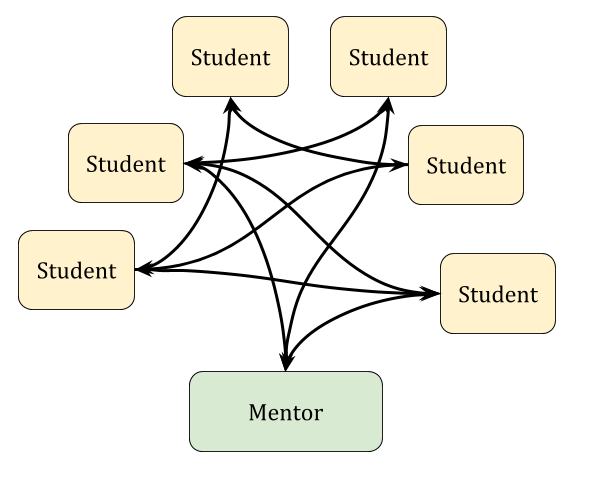How do you get your group to talk?
Asking the entire group a general question is often all that is needed to start up a discussion. However, this does not always go smoothly in groups that do not know each other very well yet. Fortunately, there are various discussion techniques that can be used to improve such group discussions.
Ingredients for a good discussion include showing interest verbally as well as non-verbally, listening, summarising and continuing to ask questions.
The first question
The first question and the first answer are usually the hardest. Experienced group interviewers tend to ask ‘the group’ questions, while in fact making sure that someone feels personally addressed. You can do this by looking directly at someone while asking your question, or, to address someone even more directly, using their name. Be sure to think about setting the right tone when doing this.
Tell something yourself
You could start up the discussion by talking about your own experiences, for example your first months in Groningen, your first semester, the time you spent doing all the wrong – or right – things, problems due to not registering for an exam, following a lecture after a long night out on the town or combining studying with a sports club or student association.
Talk about both successes and failures, and ask whether your group members recognise any of these. Questions will often arise on the basis of your stories.
(Painful) silence
Another important skill is coping with silence. When you ask a question, you may feel that people think too long before answering. It is very easy to make the mistake of breaking the silence while your discussion partner is still thinking by reformulating the question or even asking a different question altogether. This way, the person who is supposed to answer the question does not get a chance to do so.
Do not ask another question, even if you can hardly resist the temptation of breaking the silence. What you could do, however, is say that you have apparently asked a difficult question.
Open and closed questions
Open questions stimulate people to give long answers more than closed questions do, as the latter can be answered by just saying yes or no. Unfortunately, many people tend to ask taciturn people closed questions. And while they are saying yes or no, you will immediately have to come up with a new question, thus turning the discussion into a strenuous interview. Here are a few examples of open and closed questions.
| Open questions | Closed questions |
|---|---|
| Tell us something about your holiday… | Have you been on holiday? |
| What are your ambitions? | Do you want to be an economist? |
| What is your dream career? | Do you want to make a lot of money? |
| How are your studies going? | Are you studying hard? |
Although these questions may not be very creative, they do illustrate the difference between open and closed questions. Open questions call for extensive answers, whereas the more reserved type of people will answer any closed question by merely saying yes or no. Our advice: always try to ask open questions.
Probing – by not asking anything
If you do ask a closed question, and you get yes or no for an answer, there are several different ways to react. You could literally ask for an explanation: ‘Could you explain that?’, ‘Could you tell us a bit more about that?’, ‘How did you do that?’, for example. This technique is called probing. However, you can also probe by not saying anything at all. Keeping silent and looking directly at the person in question – thus non-verbally indicating that you want them to keep talking – will make this person feel called upon, and they will want to break the painful silence within about ten seconds.
Endless discussions
Something that is at least as hard to deal with as a non-talking group is a group (or some members of a group) that endlessly keeps discussing each and every topic. Having discussions going on indefinitely does not benefit the group atmosphere and will lead unnecessary competition. Endless discussions are not about finding truth but about scoring, being proven right and browbeating the others.
How can these endless arguments be prevented?
You could emphasise that the main aim of the meetings is to exchange opinions and experiences. Everyone’s opinion is equally valuable and everyone has their own experiences. There is no need to reach agreement; all different opinions can co-exist. Some students may feel fine doing nothing for weeks and then making a final push towards a minimum pass mark, whereas others prefer to work on a regular basis. As a mentor, you can use all the different opinions to let your group think about different ways of studying.
Group members demanding a lot of attention
You may be confronted with a difficult group member – someone who demands a lot of attention, constantly criticises everything or is always negative. As a mentor, you may tend to pay a lot of attention to such a student, since you want to keep your group together. However, paying too much attention to one person has a drawback: attention paid to one person cannot be paid to the rest of the group. The question is whether this attention is useful, or even reasonable. It will often prove virtually impossible to include this student in the group, and the rest will be wasting their time listening to your discussion with that one person.
If you notice that one group member is demanding a lot of attention and that this jeopardises the programme content, then this is precisely the feedback you can give that person – after thanking him or her for their contribution, of course. Finally, you can also suggest to them that they might like to discuss the topic in question with you further at a more suitable moment.
Practical tips to get a group to talk
- Look at someone – Group interviewers sometimes ask the whole group a question while looking at one person in particular. This person will feel called upon to answer the question.
- Include someone’s name in the question – ‘Hans, how would you deal with this?’
- Probe – Respond to an answer by asking for an elaboration or explanation of part of the answer: ‘Could you tell us a bit more about…?’
- Probe by not saying anything – If you get a short answer, look at your discussion partner and wait for a response. Do not ask a second question and do not repeat the question. Let him or her think about the answer. Just when you start thinking ‘Now I will have to say something’… wait another ten seconds. Odds are the other person will say something!
- ‘Pass on’ a question that is directed at you – Let a fellow group member answer a question asked by someone in the group. You can ask the group for answers, ideas, etc.
- Talk about your own experiences – this can work as a ‘warm-up’ for the students’ stories
- Instead of answering a question yourself, involve the group. Students will be more involved, and they take advice from their peers more readily.
So instead of this model of communication:

You will get this model:

In the following steps we will present you with three situations that might occur during a mentor group meeting. You can use the information presented in this and the previous article to suggest a possible solution to the situation described.
Share this
Becoming a Student Assistant: Teaching and Mentoring

Becoming a Student Assistant: Teaching and Mentoring


Reach your personal and professional goals
Unlock access to hundreds of expert online courses and degrees from top universities and educators to gain accredited qualifications and professional CV-building certificates.
Join over 18 million learners to launch, switch or build upon your career, all at your own pace, across a wide range of topic areas.
Register to receive updates
-
Create an account to receive our newsletter, course recommendations and promotions.
Register for free







